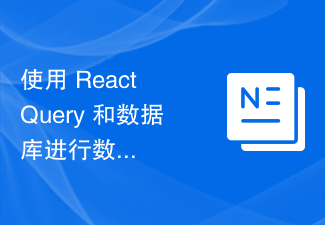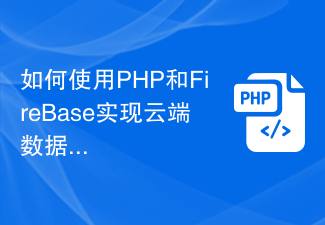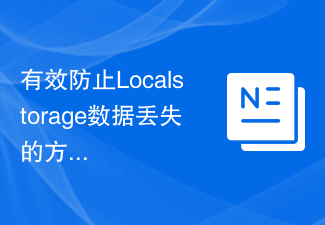Data management strategy in Vue component communication
Vue is a popular front-end development framework that uses componentization ideas to build user interfaces. In Vue development, component communication is a very important topic, because different components need to share data or transfer data. In component communication, a very important issue is how to manage data between components.
In Vue, data transfer between components can be carried out using props and $emit methods, which are two basic data transfer methods provided by Vue. The props attribute allows the parent component to pass data to the child component, and the $emit method allows the child component to send events to the parent component.
In addition to these two basic data transfer methods, Vue also provides other data management strategies, such as Vuex and provide/inject, which can help us better manage data between components.
1. Vuex
Vuex is a centralized state management model specifically for Vue.js applications. It uses a centralized approach to manage the status of all components of the application and provides some APIs to conveniently operate on the status.
In Vuex, we can define a global store object, which contains all states and methods for operating on the state. Then access the store object through this.$store in the component, and you can use some methods provided by Vuex to update the state.
The following is a simple example that demonstrates how to use Vuex to manage data in a component:
// Create a store object
const store = new Vuex.Store({
state: {
count: 0
},
mutations: {
increment(state) {
state.count++
}}
})
// Use Vuex
new in the component Vue({
el: '#app',
store,
template: `
<div>
<span>{{ $store.state.count }}</span>
<button @click="$store.commit('increment')">增加</button>
</div>`
})
In the above example, we First, a store object is created and a count state is defined in the state attribute. Then a method named increment is defined through the mutations attribute to update the count state. In the component, we access the count state through $store.state.count, and call the increment method through the $store.commit method to update the count state.
2. Provide/inject
provide/inject is a relatively rarely used data transfer method in Vue. It allows ancestor components to transfer data to descendant components. Provide and inject are used in pairs. Data is provided in the parent component through provide, and data is injected in the child component through inject.
The following is an example that demonstrates how to use provide/inject to pass data in a component:
// Parent component
const Parent = {
provide() {
return {
message: 'Hello from parent'
}},
template: `
<div> <child></child> </div>
`
}
// Child component
const Child = {
inject: [' message'],
template: `
<div>{{ message }}</div>`
}
In the above example, we provide a data named message through the provide method in the parent component , and then inject this data in the subcomponent and display it in the template.
Through the above two examples, we can see that both Vuex and provide/inject can help us better manage data between components. Vuex is suitable for medium and large applications and provides a way to centrally manage state; while provide/inject is suitable for small and medium-sized applications and provides a way for ancestor components to pass data to descendant components.
Summary:
In Vue component communication, we can choose an appropriate data management strategy based on the size and needs of the application. For small component communication, we can use props and $emit methods; for medium and large applications, we can choose to use Vuex; for small and medium applications, we can choose to use provide/inject.
The most important thing is to choose the appropriate strategy based on actual needs and reasonably manage the data between components to improve the performance and maintainability of the application.
The above is the detailed content of Data management strategies in Vue component communication. For more information, please follow other related articles on the PHP Chinese website!
 PHP中的数据备份May 24, 2023 am 08:01 AM
PHP中的数据备份May 24, 2023 am 08:01 AM在进行Web开发的过程中,数据的存储和备份无疑是非常重要的一环。面对万一出现的数据丢失或恢复需要,备份是非常必要的。对于PHP这种开源的后端语言,数据的备份同样也有许多可选的方案,下面我们就来详细了解一下PHP中的数据备份。一、数据库备份1.1MYSQLdump工具MYSQLdump是一个备份MYSQL数据库的命令行工具,它通过执行SQL语句将整个数据库或
 使用 React Query 和数据库进行数据管理:最佳实践指南Sep 27, 2023 pm 04:13 PM
使用 React Query 和数据库进行数据管理:最佳实践指南Sep 27, 2023 pm 04:13 PM使用ReactQuery和数据库进行数据管理:最佳实践指南引言:在现代的前端开发中,管理数据是一个非常重要的任务。随着用户对高性能和稳定性的需求不断增加,我们需要考虑如何更好地组织和管理应用的数据。ReactQuery是一个功能强大且易于使用的数据管理工具,它提供了一种简单而灵活的方式来处理数据的获取、更新和缓存。本文将介绍如何使用ReactQ
 如何使用PHP和FireBase实现云端数据管理Jun 25, 2023 pm 08:48 PM
如何使用PHP和FireBase实现云端数据管理Jun 25, 2023 pm 08:48 PM随着互联网的快速发展,云端数据管理已成为越来越多企业和个人的必备工具。而PHP和Firebase无疑是两个非常强大的工具,可以帮助我们实现云端数据管理。接下来,本文将会介绍如何使用PHP和Firebase实现云端数据管理。什么是FirebaseFirebase是一个由Google提供的云服务平台,旨在帮助开发人员快速构建出高质量、高可靠性的Web应用程序。F
 Vue如何实现组件的复用和扩展?Jun 27, 2023 am 10:22 AM
Vue如何实现组件的复用和扩展?Jun 27, 2023 am 10:22 AM随着前端技术的不断发展,Vue已经成为了前端开发中的热门框架之一。在Vue中,组件是其中的核心概念之一,它可以将页面分解为更小,更易管理的部分,从而提高开发效率和代码复用性。本文将重点介绍Vue如何实现组件的复用和扩展。一、Vue组件复用mixinsmixins是Vue中的一种共享组件选项的方式。Mixins允许将多个组件的组件选项合并成一个对象,从而最大
 Linux和Docker:如何进行容器的持久化存储和数据管理?Jul 29, 2023 am 11:49 AM
Linux和Docker:如何进行容器的持久化存储和数据管理?Jul 29, 2023 am 11:49 AMLinux和Docker:如何进行容器的持久化存储和数据管理?在容器化技术的应用中,容器的持久化存储和数据管理是非常重要的一环。本文将介绍如何在Linux和Docker中实现容器的持久化存储,并提供相应的代码示例。一、Docker中的容器持久化存储在Docker中,容器是通过镜像来创建的,而镜像本身是只读的。因此,当容器被删除后,其内部的数据也会随之丢失。为
 有效防止Localstorage数据丢失的方法Jan 13, 2024 am 10:25 AM
有效防止Localstorage数据丢失的方法Jan 13, 2024 am 10:25 AM如何避免Localstorage数据丢失?随着Web应用程序的发展,数据的持久化成为了一个重要的问题。而Localstorage是一种非常常用的浏览器提供的数据持久化方案。但是,由于各种原因,LocalStorage中存储的数据有可能会丢失。本文将介绍几种避免LocalStorage数据丢失的方法,并提供具体的代码示例。一、定期备份数据定期备份数据是避免Lo
 Vue项目中如何进行数据的本地存储和管理Oct 08, 2023 pm 12:05 PM
Vue项目中如何进行数据的本地存储和管理Oct 08, 2023 pm 12:05 PMVue项目中数据的本地存储和管理是非常重要的,可以使用浏览器提供的本地存储API来实现数据的持久化存储。本文将介绍如何在Vue项目中使用localStorage来进行数据的本地存储和管理,并提供具体的代码示例。初始化数据在Vue项目中,首先需要初始化需要进行本地存储的数据。可以在Vue组件的data选项中定义初始数据,并通过created钩子函数来检查是否已
 MySQL和PostgreSQL:如何最佳地管理大型数据集?Jul 12, 2023 pm 02:52 PM
MySQL和PostgreSQL:如何最佳地管理大型数据集?Jul 12, 2023 pm 02:52 PMMySQL和PostgreSQL:如何最佳地管理大型数据集?随着时代的发展,数据量的增长速度越来越快,特别是大型企业和互联网公司的数据库。在这种情况下,有效地管理和处理大规模的数据集变得至关重要。MySQL和PostgreSQL是两个最受欢迎和广泛使用的关系型数据库管理系统,本文将探讨如何在这两个数据库中最佳地管理大型数据集。索引的优化在处理大量数据时,索引


Hot AI Tools

Undresser.AI Undress
AI-powered app for creating realistic nude photos

AI Clothes Remover
Online AI tool for removing clothes from photos.

Undress AI Tool
Undress images for free

Clothoff.io
AI clothes remover

AI Hentai Generator
Generate AI Hentai for free.

Hot Article

Hot Tools

SublimeText3 English version
Recommended: Win version, supports code prompts!

SAP NetWeaver Server Adapter for Eclipse
Integrate Eclipse with SAP NetWeaver application server.

WebStorm Mac version
Useful JavaScript development tools

SublimeText3 Linux new version
SublimeText3 Linux latest version

MinGW - Minimalist GNU for Windows
This project is in the process of being migrated to osdn.net/projects/mingw, you can continue to follow us there. MinGW: A native Windows port of the GNU Compiler Collection (GCC), freely distributable import libraries and header files for building native Windows applications; includes extensions to the MSVC runtime to support C99 functionality. All MinGW software can run on 64-bit Windows platforms.






